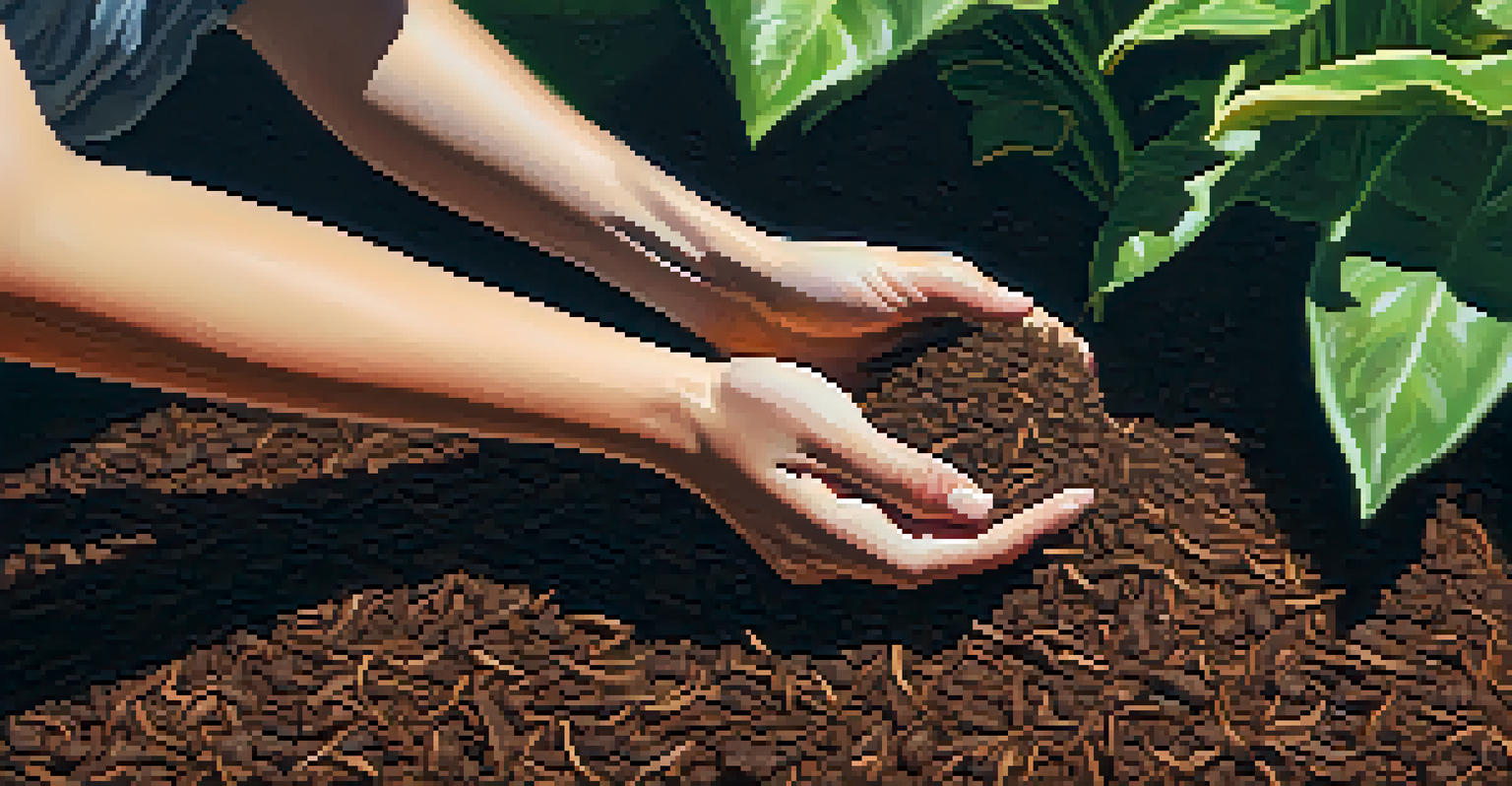Organic Mulching Techniques for Sustainable Landscapes

Understanding the Importance of Organic Mulch
Organic mulch plays a crucial role in sustainable landscaping. It not only conserves moisture in the soil but also suppresses weeds, reducing the need for chemical herbicides. Additionally, as organic materials break down, they enrich the soil with nutrients, fostering healthier plant growth.
The best way to improve your soil is to add organic matter, and mulch is a great way to do that.
Think of organic mulch as a cozy blanket for your garden. It keeps the soil temperature consistent, protecting roots from extreme heat or cold. This protective layer helps create a microclimate that benefits both plants and beneficial organisms in the soil.
Using organic mulch is an eco-friendly way to enhance your garden's health. Instead of relying on synthetic materials, you can utilize natural resources that improve soil quality and promote biodiversity in your landscape.
Types of Organic Mulch to Consider
There are various types of organic mulch you can choose from, including wood chips, straw, grass clippings, and shredded leaves. Each type offers unique benefits; for instance, wood chips break down slowly, providing long-lasting coverage, while straw is excellent for vegetable gardens due to its lightweight nature.

When selecting mulch, consider your garden's specific needs. For flower beds, colorful wood chips can enhance aesthetics, while shredded leaves are perfect for adding nutrients to a vegetable garden. Remember, the right choice can elevate both the look and health of your landscape.
Benefits of Organic Mulch
Organic mulch conserves moisture, suppresses weeds, and enriches soil, promoting healthier plant growth.
It's important to source your organic mulch responsibly. Using local materials not only reduces transportation emissions but also supports local businesses, making your gardening efforts more sustainable.
How to Apply Organic Mulch Effectively
Applying organic mulch may seem simple, but there are techniques to maximize its effectiveness. Start by clearing the area of weeds and debris, then lay down an even layer of mulch, typically 2 to 4 inches thick. This thickness helps retain moisture while preventing weed growth.
Gardening is a way of showing that you believe in tomorrow.
Be sure to keep mulch a few inches away from plant stems and tree trunks. This practice prevents moisture buildup that can lead to rot and disease. Think of it as giving plants a little breathing space while still providing them with the protective benefits of mulch.
Regularly check your mulch layer for signs of decomposition. As it breaks down, you might need to replenish it to maintain its benefits. This ongoing care ensures your landscape remains healthy and vibrant throughout the growing season.
Benefits of Using Local Organic Mulch Sources
Using local organic mulch sources can significantly enhance your gardening practices. Not only does it reduce your carbon footprint by minimizing transportation, but it also supports your local ecosystem. Local mulches often contain native plant materials, which can help attract beneficial insects and pollinators.
Furthermore, local organic mulch tends to be fresher and more suited to your specific climate. This local relevance means better compatibility with your soil and plants, leading to improved growth and resilience. It's like choosing ingredients from your own garden rather than shipped produce from far away.
Choosing Local Mulch Sources
Sourcing local organic mulch reduces transportation emissions and supports the local ecosystem, enhancing garden health.
Incorporating local mulch sources fosters a sense of community. When you source from nearby suppliers, you build relationships and contribute to the sustainability of your region, making your gardening journey even more rewarding.
Preventing Pests with Organic Mulching Techniques
Organic mulching can serve as a natural pest deterrent. Certain types of mulch, like cedar chips, have properties that repel insects, providing a chemical-free way to protect your plants. By creating a barrier between the soil and the air, mulch can also hinder pests from reaching your plants.
Additionally, a thick layer of organic mulch can help regulate soil moisture, which is essential for plant health. Healthy plants are less susceptible to pest infestations, creating a self-sustaining cycle where a robust garden naturally resists pests.
Consider integrating companion planting with your mulching strategy. By pairing certain plants together, you can enhance pest control. For instance, planting marigolds alongside vegetables can naturally ward off nematodes, while organic mulch keeps both plants healthy and thriving.
Composting: The Secret to Quality Organic Mulch
Composting is a fantastic way to create your own organic mulch that’s rich in nutrients. By recycling kitchen scraps and yard waste, you can produce a high-quality mulch that not only covers your garden but also feeds it. This closed-loop system enhances sustainability and reduces landfill waste.
To start composting, create a mix of green materials like vegetable scraps and brown materials like dried leaves. Over time, microorganisms break down these materials into nutrient-rich compost that can be used as mulch. It’s a great way to ensure your garden receives the best organic matter available.
Maintaining Mulch for Success
Proper maintenance of organic mulch, including regular replenishment and monitoring for pests, ensures optimal garden health.
Using homemade compost as mulch not only saves money but also gives you control over what goes into your garden. You can tailor your compost to meet the specific needs of your plants, ensuring they receive the ideal mix of nutrients for optimal growth.
Maintaining Your Organic Mulch for Optimal Results
To reap the full benefits of your organic mulch, proper maintenance is key. Regularly inspect the mulch layer for signs of decomposition and replenish it as needed. This upkeep helps maintain its effectiveness in moisture retention and weed suppression.
Don't forget to monitor the pH levels of your soil, especially if you're using materials that can alter it, like pine needles. Adjusting your mulch choices based on soil tests can help keep your plants healthy and thriving in their environment.

Lastly, be attentive to any pest or disease issues that may arise. Maintaining a healthy mulch layer can help minimize these problems, but early detection is crucial. By staying proactive, you can ensure your sustainable landscape remains vibrant and flourishing.